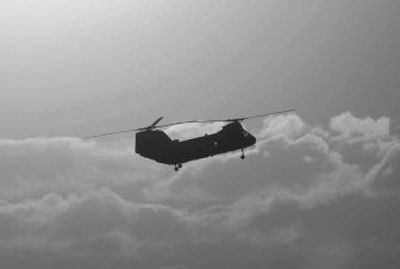U.S. loses 5th copter in 3 weeks in Iraq

WASHINGTON – The crash of the fifth U.S. helicopter in Iraq in three weeks on Wednesday comes as the military is running out of options to prevent such losses.
First, helicopter pilots tried flying low and fast, hoping to elude heat-seeking missiles fired by insurgents. The insurgents responded with high-caliber machine guns and rocket-propelled grenades, which proved deadly, and the loss rate of U.S. helicopters soared.
So the pilots went high and the insurgents responded with lethal surface-to-air missiles.
Now, this grim exchange may have claimed more victims, with a U.S. Marine Corps CH-46 helicopter lost Wednesday 20 miles northeast of Baghdad. Five Marines and two Navy hospital corpsmen on board were killed amid confusion about whether the twin-rotor troop carrier was shot down or crashed because of mechanical problems.
There is no question that Iraq is becoming increasingly dangerous for the several hundred U.S. military helicopters flying there.
With some 4,000 to 5,000 increasingly sophisticated SAMs in the hands of insurgents via the international arms markets, analysts say, U.S. chopper pilots are caught in a narrowing flight envelope in which they can operate with relative safety.
Four helicopters have been shot down in Iraq since Jan. 20, including two AH-64 Apache attack helicopters, a UH-60 Black Hawk helicopter and a commercial MD530F helicopter operated by the private security firm Blackwater USA. Twenty-seven crew and passengers were killed.
Helicopters are often at their most vulnerable flying the missions on which U.S. troops in Iraq rely: delivering ammo, airlifting assault troops for a surprise raid, evacuating casualties and gunning down fleeing insurgents.
“The problem with being down low is the small-arms threat,” said Brig. Gen. Robert Milstead, a Cobra pilot who recently returned from commanding a Marine air wing in Iraq. “Above about 2,500 or 3,000 feet you are out of small-arms range, but you gotta worry about the manpad threat,” he said, referring to “man-portable air defense” weapons, or SAMs.
With almost four years experience flying in Iraq have come major changes in tactics and technology, said Army Col. Bob Quackenbush, an Apache attack helicopter pilot who supervises Army aviation programs at the Pentagon. The Army has added armored crew seats on its Black Hawk helicopters, for instance, along with ballistic shielding of critical engine components, and in some instances fitting vulnerable interior sections of the fuselage with ballistic blankets.
The problem is that helicopters must remain light, limiting the amount of armor they can carry.
The threat to helicopters in Iraq also caused a major shift in tactics, Quackenbush said. Pilots groomed on Cold War tactics of hugging the terrain and popping up to fire at enemy tanks now found themselves learning a high-speed maneuvering tactic called “running and diving fire.”
“You’re firing on the move, keeping your speed up, operating at a higher altitude where it’s safe,” he said this week.
Each loss of a helicopter and crew brings an official statement saying the military is studying new tactics. But this style of warfare requires that helicopters operate over mostly hostile territory, and pilots say there are few tactics that haven’t been tried.
“In many cases we are using tactics that were developed in Vietnam,” said Marine Maj. Gen. Kenneth J. Glueck Jr., an attack helicopter pilot who commands the 2nd Marine Aircraft Wing at Cherry Point, N.C. “There is nothing new about this.”